Albrecht Durer Was Known for This Type if Art Shown Above
| Albrecht Dürer | |
|---|---|
 Dürer's self-portrait at 26, Prado Museum | |
| Born | (1471-05-21)21 May 1471 Nuremberg, Complimentary Imperial Urban center of Nuremberg, Holy Roman Empire |
| Died | 6 April 1528(1528-04-06) (aged 56) Nuremberg, Holy Roman Empire |
| Nationality | German |
| Other names | Adalbert Ajtósi, Albrecht Durer, Albrecht Duerer |
| Known for |
|
| Move | High Renaissance |
| Spouse(southward) | Agnes Frey (k. 1494) |
Albrecht Dürer (;[i] High german: [ˈʔalbʁɛçt ˈdyːʁɐ];[2] [3] [1] Hungarian: Ajtósi Adalbert; 21 May 1471 – 6 Apr 1528),[4] sometimes spelled in English as Durer (without an umlaut) or Duerer, was a German painter, printmaker, and theorist of the German Renaissance. Born in Nuremberg, Dürer established his reputation and influence across Europe in his twenties due to his high-quality woodcut prints. He was in contact with the major Italian artists of his time, including Raphael, Giovanni Bellini, and Leonardo da Vinci, and from 1512 was patronized past Emperor Maximilian I.

Dürer's vast body of work includes engravings, his preferred technique in his later prints, altarpieces, portraits and self-portraits, watercolours and books. The woodcuts serial are more than Gothic than the remainder of his piece of work. His well-known engravings include the three Meisterstiche (master prints) Knight, Decease and the Devil (1513), Saint Jerome in his Study (1514), and Melencolia I (1514). His watercolours marking him as 1 of the first European landscape artists, while his woodcuts revolutionised the potential of that medium.
Dürer'south introduction of classical motifs into Northern fine art, through his knowledge of Italian artists and German humanists, has secured his reputation as 1 of the near important figures of the Northern Renaissance. This is reinforced by his theoretical treatises, which involve principles of mathematics, perspective, and platonic proportions.
Biography [edit]
Early life (1471–1490) [edit]

Dürer was born on 21 May 1471, the third child and second son of Albrecht Dürer the Elder and Barbara Holper, who married in 1467 and had eighteen children together.[5] [6] Albrecht Dürer the Elderberry (originally Albrecht Ajtósi), was a successful goldsmith who by 1455 had moved to Nuremberg from Ajtós, about Gyula in Hungary.[7] He married Holper, his master's daughter, when he himself qualified as a master.[6] Ane of Albrecht's brothers, Hans Dürer, was as well a painter and trained nether him. Another of Albrecht's brothers, Endres Dürer, took over their father's concern and was a master goldsmith.[eight] The German name "Dürer" is a translation from the Hungarian, "Ajtósi".[7] Initially, it was "Türer", meaning doormaker, which is "ajtós" in Hungarian (from "ajtó", meaning door). A door is featured in the glaze-of-artillery the family unit acquired. Albrecht Dürer the Younger afterward changed "Türer", his begetter'southward diction of the family'south surname, to "Dürer", to adjust to the local Nuremberg dialect.[6]

Woodcut past Dürer of his coat of artillery, which featured a door equally a pun on his name, as well as the winged bust of a Moor
Dürer's godfather Anton Koberger left goldsmithing to become a printer and publisher in the year of Dürer's birth. He became the most successful publisher in Germany, somewhen owning twenty-four press-presses and a number of offices in Germany and abroad. Koberger's most famous publication was the Nuremberg Relate, published in 1493 in German and Latin editions. It independent an unprecedented 1,809 woodcut illustrations (albeit with many repeated uses of the aforementioned block) past the Wolgemut workshop. Dürer may have worked on some of these, equally the work on the projection began while he was with Wolgemut.[9]
Because Dürer left autobiographical writings and was widely known by his mid-twenties, his life is well documented in several sources. After a few years of school, Dürer learned the basics of goldsmithing and cartoon from his father. Though his begetter wanted him to continue his training equally a goldsmith, he showed such a precocious talent in drawing that he started as an apprentice to Michael Wolgemut at the age of fifteen in 1486.[10] A self-portrait, a drawing in silverpoint, is dated 1484 (Albertina, Vienna) "when I was a child", as his later inscription says. The drawing is one of the primeval surviving children'southward drawings of whatsoever kind, and, equally Dürer'southward Opus One, has helped define his oeuvre every bit deriving from, and e'er linked to, himself.[11] Wolgemut was the leading artist in Nuremberg at the time, with a big workshop producing a diverseness of works of fine art, in particular woodcuts for books. Nuremberg was then an important and prosperous metropolis, a centre for publishing and many luxury trades. It had potent links with Italy, specially Venice, a relatively short distance beyond the Alps.[ix]
Wanderjahre and marriage (1490–1494) [edit]
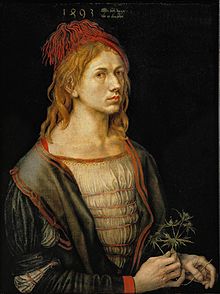
Subsequently completing his apprenticeship, Dürer followed the common German custom of taking Wanderjahre—in effect gap years—in which the amateur learned skills from artists in other areas; Dürer was to spend near four years abroad. He left in 1490, peradventure to work under Martin Schongauer, the leading engraver of Northern Europe, but who died presently before Dürer's inflow at Colmar in 1492. Information technology is unclear where Dürer travelled in the intervening period, though it is probable that he went to Frankfurt and holland. In Colmar, Dürer was welcomed by Schongauer's brothers, the goldsmiths Caspar and Paul and the painter Ludwig. In 1493 Dürer went to Strasbourg, where he would have experienced the sculpture of Nikolaus Gerhaert. Dürer's starting time painted self-portrait (now in the Louvre) was painted at this time, probably to be sent back to his fiancée in Nuremberg.[9]
In early 1492 Dürer travelled to Basel to stay with another brother of Martin Schongauer, the goldsmith Georg.[n 1] Very soon later his return to Nuremberg, on 7 July 1494, at the age of 23, Dürer was married to Agnes Frey following an organization made during his absence. Agnes was the girl of a prominent contumely worker (and amateur harpist) in the city. Withal, no children resulted from the marriage, and with Albrecht the Dürer name died out. The marriage between Agnes and Albrecht was not a generally happy ane, as indicated past the letters of Dürer in which he quipped to Willibald Pirckheimer in an extremely rough tone virtually his wife. He called her an "former crow" and made other vulgar remarks. Pirckheimer too fabricated no secret of his antipathy towards Agnes, describing her equally a miserly shrew with a bitter tongue, who helped cause Dürer'southward decease at a young age.[12] One author speculates that Albrecht was bisexual, if not homosexual, due to several of his works containing themes of homosexual desire, also as the intimate nature of his correspondence with certain very close male friends.[xiii]
First journey to Italy (1494–1495) [edit]

Dürer's sketch of his married woman Agnes Frey (1494)
Within three months of his matrimony, Dürer left for Italy, alone, perhaps stimulated by an outbreak of plague in Nuremberg. He made watercolour sketches as he traveled over the Alps. Some take survived and others may be deduced from authentic landscapes of existent places in his later piece of work, for example his engraving Nemesis.
In Italy, he went to Venice to study its more advanced artistic globe.[14] Through Wolgemut's tutelage, Dürer had learned how to make prints in drypoint and pattern woodcuts in the German style, based on the works of Schongauer and the Housebook Master.[14] He also would take had admission to some Italian works in Germany, but the two visits he made to Italia had an enormous influence on him. He wrote that Giovanni Bellini was the oldest and still the best of the artists in Venice. His drawings and engravings show the influence of others, notably Antonio del Pollaiuolo, with his involvement in the proportions of the body; Lorenzo di Credi; and Andrea Mantegna, whose work he produced copies of while training.[15] Dürer probably besides visited Padua and Mantua on this trip.[n 2]
Render to Nuremberg (1495–1505) [edit]

On his return to Nuremberg in 1495, Dürer opened his own workshop (being married was a requirement for this). Over the next five years, his style increasingly integrated Italian influences into underlying Northern forms. Arguably his best works in the first years of the workshop were his woodcut prints, mostly religious, but including secular scenes such equally The Men's Bath House (ca. 1496). These were larger and more than finely cut than the great majority of German woodcuts hitherto, and far more complex and balanced in composition.
It is now idea unlikely that Dürer cut whatsoever of the woodblocks himself; this chore would have been performed past a specialist craftsman. Even so, his training in Wolgemut's studio, which made many carved and painted altarpieces and both designed and cut woodblocks for woodcut, evidently gave him great understanding of what the technique could be made to produce, and how to work with block cutters. Dürer either drew his design directly onto the woodblock itself, or glued a paper drawing to the cake. Either manner, his drawings were destroyed during the cutting of the cake.

Portrait of Oswolt Krel, a merchant from Lindau (Lake Constance), participating in the South High german medieval merchandise corporation Große Ravensburger Handelsgesellschaft, 1499.
His series of sixteen designs for the Apocalypse[16] is dated 1498, as is his engraving of St. Michael Fighting the Dragon. He made the beginning vii scenes of the Great Passion in the aforementioned year, and a piddling later, a series of eleven on the Holy Family unit and saints. The Vii Sorrows Polyptych, commissioned by Frederick III of Saxony in 1496, was executed by Dürer and his assistants c. 1500. In 1502, Dürer's male parent died. Around 1503–1505 Dürer produced the first 17 of a set illustrating the Life of the Virgin, which he did not finish for some years. Neither these nor the Great Passion were published as sets until several years afterwards, only prints were sold individually in considerable numbers.[9]
During the same period Dürer trained himself in the hard art of using the burin to make engravings. It is possible he had begun learning this skill during his early on grooming with his father, as information technology was also an essential skill of the goldsmith. In 1496 he executed the Prodigal Son, which the Italian Renaissance art historian Giorgio Vasari singled out for praise some decades later on, noting its Germanic quality. He was before long producing some spectacular and original images, notably Nemesis (1502), The Sea Monster (1498), and Saint Eustace (c. 1501), with a highly detailed mural groundwork and animals. His landscapes of this flow, such every bit Pond in the Forest and Willow Mill, are quite different from his earlier watercolours. There is a much greater emphasis on capturing atmosphere, rather than depicting topography. He made a number of Madonnas, unmarried religious figures, and pocket-size scenes with comic peasant figures. Prints are highly portable and these works fabricated Dürer famous throughout the master artistic centres of Europe within a very few years.[9]

The Venetian artist Jacopo de' Barbari, whom Dürer had met in Venice, visited Nuremberg in 1500, and Dürer said that he learned much about the new developments in perspective, anatomy, and proportion from him.[17] De' Barbari was unwilling to explain everything he knew, so Dürer began his ain studies, which would get a lifelong preoccupation. A serial of extant drawings show Dürer'southward experiments in human proportion, leading to the famous engraving of Adam and Eve (1504), which shows his subtlety while using the burin in the texturing of mankind surfaces.[9] This is the only existing engraving signed with his full name.
Dürer created large numbers of preparatory drawings, especially for his paintings and engravings, and many survive, about famously the Betende Hände (Praying Hands) from circa 1508, a study for an apostle in the Heller altarpiece. He continued to make images in watercolour and bodycolour (usually combined), including a number of withal lifes of meadow sections or animals, including his Young Hare (1502) and the Neat Piece of Turf (1503).
Second journey to Italy (1505–1507) [edit]
In Italian republic, he returned to painting, at offset producing a series of works executed in tempera on linen. These include portraits and altarpieces, notably, the Paumgartner altarpiece and the Admiration of the Magi. In early 1506, he returned to Venice and stayed at that place until the bound of 1507.[4] Past this time Dürer'due south engravings had attained great popularity and were existence copied. In Venice he was given a valuable committee from the emigrant German customs for the church of San Bartolomeo. This was the altar-piece known equally the Admiration of the Virgin or the Feast of Rose Garlands. Information technology includes portraits of members of Venice'southward German customs, but shows a strong Italian influence. It was later acquired by the Emperor Rudolf Ii and taken to Prague.[18]
Nuremberg and the masterworks (1507–1520) [edit]


Despite the regard in which he was held by the Venetians, Dürer returned to Nuremberg by mid-1507, remaining in Federal republic of germany until 1520. His reputation had spread throughout Europe and he was on friendly terms and in advice with most of the major artists including Raphael.[north 3]
Between 1507 and 1511 Dürer worked on some of his about historic paintings: Adam and Eve (1507), Martyrdom of the Ten Thousand (1508, for Frederick of Saxony), Virgin with the Iris (1508), the altarpiece Assumption of the Virgin (1509, for Jacob Heller of Frankfurt), and Admiration of the Trinity (1511, for Matthaeus Landauer). During this period he also completed two woodcut series, the Bang-up Passion and the Life of the Virgin, both published in 1511 together with a 2nd edition of the Apocalypse series. The post-Venetian woodcuts show Dürer's evolution of chiaroscuro modelling furnishings,[twenty] creating a mid-tone throughout the print to which the highlights and shadows tin exist contrasted.
Other works from this menses include the thirty-seven Little Passion woodcuts, get-go published in 1511, and a set of fifteen pocket-size engravings on the same theme in 1512. Complaining that painting did not make enough money to justify the time spent when compared to his prints, he produced no paintings from 1513 to 1516. In 1513 and 1514 Dürer created his three most famous engravings: Knight, Death and the Devil (1513, probably based on Erasmus's Handbook of a Christian Knight),[21] St. Jerome in His Study, and the much-debated Melencolia I (both 1514, the year Dürer's mother died).[n 4] Further outstanding pen and ink drawings of Dürer'due south period of art work of 1513 were drafts for his friend Pirckheimer. These drafts were later used to design Lusterweibchen chandeliers, combining an antler with a wooden sculpture.
In 1515, he created his woodcut of a Rhino which had arrived in Lisbon from a written description and sketch past another artist, without always seeing the animal himself. An prototype of the Indian rhinoceros, the paradigm has such force that it remains one of his best-known and was still used in some German school science text-books equally late as last century.[9] In the years leading to 1520 he produced a broad range of works, including the woodblocks for the showtime western printed star charts in 1515[23] and portraits in tempera on linen in 1516. His only experiments with etching came in this catamenia, producing five betwixt 1515–1516 and a sixth in 1518; a technique he may have abandoned as unsuited to his aesthetic of methodical, classical form.[24]
Patronage of Maximilian I [edit]
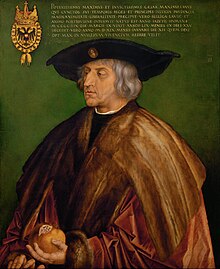
From 1512, Maximilian I became Dürer's major patron. He commissioned The Triumphal Curvation, a vast piece of work printed from 192 dissever blocks, the symbolism of which is partly informed past Pirckheimer'due south translation of Horapollo's Hieroglyphica. The design programme and explanations were devised by Johannes Stabius, the architectural pattern by the chief builder and court-painter Jörg Kölderer and the woodcutting itself by Hieronymous Andreae, with Dürer as designer-in-principal. The Arch was followed by The Triumphal Procession, the program of which was worked out in 1512 by Marx Treitz-Saurwein and includes woodcuts by Albrecht Altdorfer and Hans Springinklee, too as Dürer.
Dürer worked with pen on the marginal images for an edition of the Emperor's printed Prayer-Book; these were quite unknown until facsimiles were published in 1808 every bit office of the first book published in lithography. Dürer's piece of work on the book was halted for an unknown reason, and the decoration was continued past artists including Lucas Cranach the Elderberry and Hans Baldung. Dürer likewise fabricated several portraits of the Emperor, including i shortly before Maximilian's death in 1519.
Maximilian was a very cash-strapped prince who sometimes failed to pay, yet turned out to be Dürer's most important patron.[25] [26] [27] In his courtroom, artists and learned men were respected, which was non mutual at that time (later, Dürer commented that in Germany, as a non-noble, he was treated as a parasite).[28] [29] Pirckheimer (who he met in 1495, earlier entering the service of Maximilian) was too an important personage in the courtroom and nifty cultural patron, who had a strong influence on Dürer every bit his tutor in classical noesis and humanistic critical methodology, equally well every bit collaborator.[30] [31] In Maximilian's court, Dürer likewise collaborated with a dandy number of other bright artists and scholars of the fourth dimension who became his friends, like Johannes Stabius, Konrad Peutinger, Conrad Celtes, and Hans Tscherte (an imperial architect).[32] [33] [34] [35]
Dürer manifested a strong pride in his ability, equally a prince of his profession.[36] One day, the emperor, trying to show Dürer an thought, tried to sketch with the charcoal himself, merely ever bankrupt it. Dürer took the charcoal from Maximilian's mitt, finished the drawing and told him: "This is my scepter."[37] [38] [39]
In another occasion, Maximilian noticed that the ladder Dürer used was too short and unstable, thus told a noble to concur it for him. The noble refused, saying that it was beneath him to serve a non-noble. Maximilian then came to concur the ladder himself, and told the noble that he could make a noble out of a peasant whatsoever day, but he could not make an artist like Dürer out of a noble.[40] [41] [42]
Cartographic and astronomical works [edit]
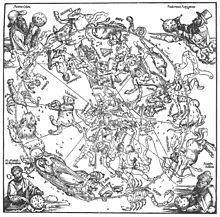
The Northern Hemisphere of the Angelic Globe, created by Albrecht Dürer under the management of Stabius and Konrad Heinfogel
Dürer'south exploration of space led to a relationship and cooperation with the court astronomer Johannes Stabius.[43] Stabius besides often acted equally Dürer's and Maximilian'due south get-betwixt for their financial problems.[44]
In 1515 Dürer and Stabius created the offset world map projected on a solid geometric sphere.[45] As well in 1515, Stabius, Dürer and the astronomer Konrad Heinfogel produced the start planispheres of both southern and northerns hemispheres, as well as the first printed celestial maps, which prompted the revival of involvement in the field of uranometry throughout Europe.[46] [47] [48] [49]
Journey to the Netherlands (1520–1521) [edit]
Maximilian's death came at a time when Dürer was concerned he was losing "my sight and liberty of hand" (mayhap caused by arthritis) and increasingly afflicted by the writings of Martin Luther.[50] In July 1520 Dürer made his quaternary and terminal major journey, to renew the Imperial alimony Maximilian had given him and to secure the patronage of the new emperor, Charles V, who was to be crowned at Aachen. Dürer journeyed with his wife and her maid via the Rhine to Cologne and then to Antwerp, where he was well received and produced numerous drawings in silverpoint, chalk and charcoal. In addition to attending the coronation, he visited Cologne (where he admired the painting of Stefan Lochner), Nijmegen, 's-Hertogenbosch, Bruges (where he saw Michelangelo's Madonna of Bruges), Ghent (where he admired van Eyck'south Ghent altarpiece),[51] and Zeeland.
Dürer took a large stock of prints with him and wrote in his diary to whom he gave, exchanged or sold them, and for how much. This provides rare information of the monetary value placed on prints at this fourth dimension. Different paintings, their sale was very rarely documented.[52] While providing valuable documentary evidence, Dürer'south Netherlandish diary also reveals that the trip was not a profitable one. For instance, Dürer offered his terminal portrait of Maximilian to his daughter, Margaret of Austria, but eventually traded the picture for some white fabric after Margaret disliked the portrait and declined to accept it. During this trip he also met Bernard van Orley, Jan Provoost, Gerard Horenbout, Jean Mone, Joachim Patinir and Tommaso Vincidor, though he did non, it seems, see Quentin Matsys.[53]
Having secured his pension, Dürer returned home in July 1521, having defenseless an undetermined affliction, which afflicted him for the rest of his life, and profoundly reduced his rate of work.[nine]
Final years, Nuremberg (1521–1528) [edit]

Salvator Mundi, an unfinished oil painting on forest, total painting
On his return to Nuremberg, Dürer worked on a number of grand projects with religious themes, including a crucifixion scene and a Sacra conversazione, though neither was completed.[54] This may have been due in part to his failing health, but perhaps too because of the time he gave to the training of his theoretical works on geometry and perspective, the proportions of men and horses, and fortification.
Nonetheless, ane effect of this shift in accent was that during the last years of his life, Dürer produced comparatively piffling as an creative person. In painting, at that place was merely a portrait of Hieronymus Holtzschuher, a Madonna and Child (1526), Salvator Mundi (1526), and two panels showing St. John with St. Peter in background and St. Paul with St. Marking in the background. This last corking work, the Four Apostles, was given past Dürer to the Metropolis of Nuremberg—although he was given 100 guilders in return.[55]
As for engravings, Dürer's piece of work was restricted to portraits and illustrations for his treatise. The portraits include Cardinal-Elector Albert of Mainz; Frederick the Wise, elector of Saxony; the humanist scholar Willibald Pirckheimer; Philipp Melanchthon, and Erasmus of Rotterdam. For those of the Fundamental, Melanchthon, and Dürer'due south final major work, a drawn portrait of the Nuremberg patrician Ulrich Starck, Dürer depicted the sitters in profile.
Despite complaining of his lack of a formal classical education, Dürer was profoundly interested in intellectual matters and learned much from his adolescence friend Willibald Pirckheimer, whom he no doubt consulted on the content of many of his images.[56] He also derived great satisfaction from his friendships and correspondence with Erasmus and other scholars. Dürer succeeded in producing 2 books during his lifetime. "The 4 Books on Measurement" were published at Nuremberg in 1525 and was the first volume for adults on mathematics in German,[9] besides as being cited later by Galileo and Kepler. The other, a work on metropolis fortifications, was published in 1527. "The Iv Books on Human Proportion" were published posthumously, shortly afterwards his death in 1528.[4]
Dürer died in Nuremberg at the age of 56, leaving an estate valued at 6,874 florins – a considerable sum. He is cached in the Johannisfriedhof cemetery. His large firm (purchased in 1509 from the heirs of the astronomer Bernhard Walther), where his workshop was located and where his widow lived until her death in 1539, remains a prominent Nuremberg landmark.[9]
Dürer and the Reformation [edit]
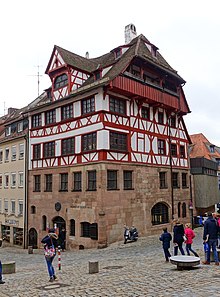
Dürer's writings suggest that he may have been sympathetic to Luther's ideas, though it is unclear if he ever left the Catholic Church. Dürer wrote of his want to draw Luther in his diary in 1520: "And God help me that I may go to Dr. Martin Luther; thus I intend to make a portrait of him with great care and engrave him on a copper plate to create a lasting memorial of the Christian human who helped me overcome and so many difficulties."[57] In a letter of the alphabet to Nicholas Kratzer in 1524, Dürer wrote, "because of our Christian religion we accept to stand in contemptuousness and danger, for nosotros are reviled and called heretics". Almost tellingly, Pirckheimer wrote in a letter to Johann Tscherte in 1530: "I confess that in the beginning I believed in Luther, similar our Albert of blest memory ... only equally anyone tin see, the situation has become worse." Dürer may even have contributed to the Nuremberg City Quango's mandating Lutheran sermons and services in March 1525. Notably, Dürer had contacts with various reformers, such as Zwingli, Andreas Karlstadt, Melanchthon, Erasmus and Cornelius Grapheus from whom Dürer received Luther's Babylonian Captivity in 1520.[58] However Erasmus and C. Grapheus are meliorate said to be Cosmic change agents. Too, from 1525, "the yr that saw the elevation and collapse of the Peasants' State of war, the artist can be seen to distance himself somewhat from the [Lutheran] movement..."[59]

The Cannon, Dürer'southward largest etching, 1518
Dürer's later works have likewise been claimed to show Protestant sympathies. His 1523 The Final Supper woodcut has often been understood to have an evangelical theme, focusing as it does on Christ espousing the Gospel, likewise as the inclusion of the Eucharistic cup, an expression of Protestant utraquism,[60] although this interpretation has been questioned.[61] The delaying of the engraving of St Philip, completed in 1523 merely not distributed until 1526, may accept been due to Dürer's uneasiness with images of saints; even if Dürer was not an iconoclast, in his last years he evaluated and questioned the role of art in faith.[62]
Legacy and influence [edit]

Adoration of the Trinity (Landauer Altar)

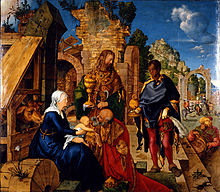
Dürer exerted a huge influence on the artists of succeeding generations, especially in printmaking, the medium through which his contemporaries by and large experienced his art, as his paintings were predominantly in private collections located in only a few cities. His success in spreading his reputation across Europe through prints was undoubtedly an inspiration for major artists such every bit Raphael, Titian, and Parmigianino, all of whom collaborated with printmakers to promote and distribute their work.
His engravings seem to have had an intimidating effect upon his German successors; the "Niggling Masters" who attempted few large engravings only continued Dürer'south themes in small, rather cramped compositions. Lucas van Leyden was the simply Northern European engraver to successfully continue to produce large engravings in the get-go third of the 16th century. The generation of Italian engravers who trained in the shadow of Dürer all either straight copied parts of his landscape backgrounds (Giulio Campagnola, Giovanni Battista Palumba, Benedetto Montagna and Cristofano Robetta), or whole prints (Marcantonio Raimondi and Agostino Veneziano). Nonetheless, Dürer's influence became less dominant afterward 1515, when Marcantonio perfected his new engraving style, which in plough travelled over the Alps to as well dominate Northern engraving.
In painting, Dürer had relatively little influence in Italia, where probably merely his altarpiece in Venice was seen, and his German successors were less effective in blending German and Italian styles. His intense and self-dramatizing self-portraits have continued to take a strong influence up to the present, especially on painters in the 19th and 20th century who desired a more dramatic portrait style. Dürer has never fallen from disquisitional favour, and there take been significant revivals of involvement in his works in Germany in the Dürer Renaissance of almost 1570 to 1630, in the early on nineteenth century, and in German nationalism from 1870 to 1945.[nine]
The Lutheran Church building commemorates Dürer annually on vi April,[63] along with Michelangelo,[64] Lucas Cranach the Elder and Hans Burgkmair. The liturgical agenda of the Episcopal Church (U.s.) remembers him, Cranach and Matthias Grünewald on five August.
Theoretical works [edit]
In all his theoretical works, in order to communicate his theories in the German language rather than in Latin, Dürer used graphic expressions based on a vernacular, craftsmen's language. For example, "Schneckenlinie" ("snail-line") was his term for a spiral form. Thus, Dürer contributed to the expansion in German prose which Luther had begun with his translation of the Bible.[55]
Four Books on Measurement [edit]
Dürer's piece of work on geometry is chosen the 4 Books on Measurement (Underweysung der Messung mit dem Zirckel und Richtscheyt or Instructions for Measuring with Compass and Ruler).[65] The offset book focuses on linear geometry. Dürer'due south geometric constructions include helices, conchoids and epicycloids. He also draws on Apollonius, and Johannes Werner's 'Libellus super viginti duobus elementis conicis' of 1522.
The 2nd book moves onto two-dimensional geometry, i.e. the construction of regular polygons.[66] Hither Dürer favours the methods of Ptolemy over Euclid. The third book applies these principles of geometry to architecture, engineering science and typography. In architecture Dürer cites Vitruvius but elaborates his own classical designs and columns. In typography, Dürer depicts the geometric structure of the Latin alphabet, relying on Italian precedent. All the same, his construction of the Gothic alphabet is based upon an entirely different modular organization. The fourth book completes the progression of the first and 2nd by moving to three-dimensional forms and the construction of polyhedra. Hither Dürer discusses the five Platonic solids, every bit well every bit 7 Archimedean semi-regular solids, likewise equally several of his own invention.
In all these, Dürer shows the objects as nets. Finally, Dürer discusses the Delian Problem and moves on to the 'construzione legittima', a method of depicting a cube in two dimensions through linear perspective. He is thought to be the start to describe a visualization technique used in modern computers, ray tracing. It was in Bologna that Dürer was taught (possibly by Luca Pacioli or Bramante) the principles of linear perspective, and evidently became familiar with the 'costruzione legittima' in a written description of these principles found merely, at this time, in the unpublished treatise of Piero della Francesca. He was also familiar with the 'abbreviated structure' equally described by Alberti and the geometrical structure of shadows, a technique of Leonardo da Vinci. Although Dürer made no innovations in these areas, he is notable as the first Northern European to treat matters of visual representation in a scientific way, and with agreement of Euclidean principles. In addition to these geometrical constructions, Dürer discusses in this last book of Underweysung der Messung an assortment of mechanisms for drawing in perspective from models and provides woodcut illustrations of these methods that are often reproduced in discussions of perspective.
Iv Books on Human Proportion [edit]

Illustration from the Four Books on Human Proportion
Dürer's work on human being proportions is called the Four Books on Human Proportion (Vier Bücher von Menschlicher Proportion) of 1528.[67] The beginning volume was mainly composed by 1512/thirteen and completed by 1523, showing v differently constructed types of both male and female person figures, all parts of the torso expressed in fractions of the total height. Dürer based these constructions on both Vitruvius and empirical observations of "2 to three hundred living persons",[55] in his own words. The second volume includes eight further types, broken down not into fractions but an Albertian system, which Dürer probably learned from Francesco di Giorgio's 'De harmonica mundi totius' of 1525. In the tertiary book, Dürer gives principles by which the proportions of the figures tin can be modified, including the mathematical simulation of convex and concave mirrors; here Dürer also deals with human physiognomy. The quaternary volume is devoted to the theory of move.[17]
Appended to the final book, however, is a self-independent essay on aesthetics, which Dürer worked on between 1512 and 1528, and it is here that we learn of his theories concerning 'ideal dazzler'. Dürer rejected Alberti's concept of an objective beauty, proposing a relativist notion of beauty based on variety. However, Dürer nevertheless believed that truth was hidden within nature, and that in that location were rules which ordered beauty, even though he found information technology hard to define the criteria for such a code. In 1512/xiii his iii criteria were function ('Nutz'), naïve approval ('Wohlgefallen') and the happy medium ('Mittelmass'). However, different Alberti and Leonardo, Dürer was most troubled by agreement non just the abstract notions of beauty but also as to how an artist tin can create cute images. Between 1512 and the final typhoon in 1528, Dürer's conventionalities developed from an understanding of human being inventiveness as spontaneous or inspired to a concept of 'selective inwards synthesis'.[55] In other words, that an artist builds on a wealth of visual experiences in order to imagine cute things. Dürer'south belief in the abilities of a single artist over inspiration prompted him to affirm that "one homo may sketch something with his pen on one-half a sheet of paper in ane day, or may cut it into a tiny piece of woods with his little iron, and it turns out to be better and more creative than another's piece of work at which its author labours with the utmost diligence for a whole yr".[68]
-
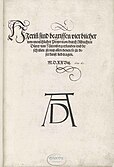
Title page of Vier Bücher von menschlicher Proportion showing the monogram signature of artist
-

-

Dürer's study of human proportions
Book on Fortification [edit]
In 1527, Dürer as well published Diverse Lessons on the Fortification of Cities, Castles, and Localities (Etliche Underricht zu Befestigung der Stett, Schloss und Flecken). It was printed in Nuremberg, probably past Hieronymus Andreae and reprinted in 1603 by Johan Janssenn in Arnhem. In 1535 it was as well translated into Latin every bit On Cities, Forts, and Castles, Designed and Strengthened by Several Manners: Presented for the Most Necessary Adaptation of War (De vrbibus, arcibus, castellisque condendis, air conditioning muniendis rationes aliquot : praesenti bellorum necessitati accommodatissimae), published by Christian Wechel (Wecheli/Wechelus) in Paris.[69]
The piece of work is less proscriptively theoretical than his other works, and was soon overshadowed past the Italian theory of polygonal fortification (the trace italienne – see Bastion fort), though his designs seem to have had some influence in the eastern German language lands and upward into the Baltic States.
Fencing [edit]
Dürer created many sketches and woodcuts of soldiers and knights over the class of his life. His nearly significant martial works, however, were made in 1512 as part of his efforts to secure the patronage of Maximilian I. Using existing manuscripts from the Nuremberg Grouping as his reference, his workshop produced the extensive Οπλοδιδασκαλια sive Armorvm Tractandorvm Meditatio Alberti Dvreri ("Weapon Preparation, or Albrecht Dürer's Meditation on the Handling of Weapons", MS 26-232). Another manuscript based on the Nuremberg texts likewise as i of Hans Talhoffer's works, the untitled Berlin Pic Volume (Libr.Pict.A.83), is also idea to have originated in his workshop effectually this time. These sketches and watercolors show the aforementioned careful attending to item and human proportion equally Dürer'southward other work, and his illustrations of grappling, long sword, dagger, and messer are amidst the highest-quality in any fencing manual.[70]
Gallery [edit]
- Paintings
-
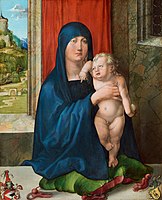
-

- Portraits
-

- Drawings and engravings
-

The Expulsion from Paradise, 1510
-

Man of Sorrows
-

Head of an Old Man, 1521
-
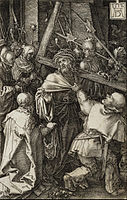
Bearing of the Cross
-

Nemesis, c. 1501/02
-

Disguised Saint in a Forest, c. 1516
-

- Watercolours
-

Innsbruck Castle Courtyard, 1494, Gouache and watercolour on paper
-

Castle Segonzano, 1502, gouache and watercolour on paper
-

Listing of works [edit]
- Listing of paintings by Albrecht Dürer
- List of engravings by Albrecht Dürer
- Listing of woodcuts past Albrecht Dürer
References [edit]
Notes [edit]
- ^ Hither he produced a woodcut of St Jerome as a frontispiece for Nicholaus Kessler's 'Epistolare beati Hieronymi'. Erwin Panofsky argues that this print combined the 'Ulmian fashion' of Koberger's 'Lives of the Saints' (1488) and that of Wolgemut'due south workshop. Panofsky (1945), 21
- ^ The testify for this trip is not conclusive; the suggestion information technology happened is supported by Panofsky (in his Albrecht Dürer, 1943) and is accepted by a majority of scholars, including the several curators of the large 2020-22 exhibition "Dürer's Journeys", just it has been disputed by other scholars, including Katherine Crawford Luber (in her Albrecht Dürer and the Venetian Renaissance, 2005)
- ^ According to Vasari, Dürer sent Raphael a self-portrait in watercolour, and Raphael sent back multiple drawings. One is dated 1515 and has an inscription by Dürer (or one of his heirs) affirming that Raphael sent it to him. Come across Salmi, Mario; Becherucci, Luisa; Marabottini, Alessandro; Tempesti, Anna Forlani; Marchini, Giuseppe; Becatti, Giovanni; Castagnoli, Ferdinando; Golzio, Vincenzo (1969). The Consummate Work of Raphael. New York: Reynal and Co., William Morrow and Company. pp. 278, 407. Dürer describes Giovanni Bellini every bit "very old, merely notwithstanding the best in painting".[xix]
- ^ In March of this twelvemonth, two months before his mother died, he drew a portrait of her.[22]
Citations [edit]
- ^ a b Wells, John C. (2008), Longman Pronunciation Dictionary (tertiary ed.), Longman, ISBN9781405881180
- ^ "Albrecht - Deutsch-Übersetzung - Langenscheidt Französisch-Deutsch Wörterbuch" (in German and French). Langenscheidt. Retrieved 22 Oct 2018.
- ^ "Duden | Dürer | Rechtschreibung, Bedeutung, Definition". Duden (in German). Retrieved 22 October 2018.
- ^ a b c Müller, Peter O. (1993) Substantiv-Derivation in Den Schriften Albrecht Dürers, Walter de Gruyter. ISBN 3-xi-012815-2.
- ^ Make Philip & Anzelewsky (1978–79), xi
- ^ a b c Bartrum, 93, note 1
- ^ a b Heaton, Mrs. Charles (1881). The Life of Albrecht Dürer of Nürnberg: With a Translation of His Letters and Journal and an Business relationship of His Works. London: Seeley, Jackson and Halliday. pp. 29, 31–32.
- ^ Brion (1960), 16
- ^ a b c d e f one thousand h i j k Giulia Bartrum, "Albrecht Dürer and his Legacy", British Museum Printing, 2002, ISBN 0-7141-2633-0
- ^ Brand Philip & Anzelewsky (1978–79), 10
- ^ Joseph Koerner, "The Moment of Self-Portraiture in Renaissance Fine art", University of Chicago Press, 1993
- ^ Harry John Wilmot-Buxton; Edward John Poynter (1881). German, Flemish and Dutch Painting. Scribner and Welford. p. 24.
- ^ George Haggerty (five November 2013). Encyclopedia of Gay Histories and Cultures. Taylor & Francis. p. 262. ISBN978-1-135-58513-half dozen.
- ^ a b Lee, Raymond 50. & Alistair B. Fraser. (2001) The Rainbow Span, Penn Land Press. ISBN 0-271-01977-8.
- ^ Campbell, Angela and Raftery, Andrew. "Remaking Dürer: Investigating the Master Engravings by Masterful Engraving," Art in Print Vol. 2 No. 4 (November–December 2012).
- ^ "Johannesapokalypse in klassischen Comics".
- ^ a b Schaar, Eckhard. "A Newly Discovered Proportional Study past Dürer in Hamburg". Primary Drawings, volume 36, no. 1, 1998. pp. 59-66. JSTOR 1554333
- ^ Kotková, Olga. "'The Banquet of the Rose Garlands': What Remains of Dürer?". The Burlington Magazine, Book 144, No. 1186, 2002. 4-thirteen. JSTOR 889418
- ^ Giovanni Bellini, The J. Paul Getty Museum
- ^ Panofsky (1945), 135
- ^ "Knight, Death, and the Devil, 1513–14". MoMA. Retrieved 11 September 2020
- ^ Tatlock, Lynne. Enduring Loss in Early Modern Deutschland. Brill Academic Publishers, 2010. 116. ISBN 90-04-18454-6
- ^ "Dürer's hemispheres of 1515—the kickoff European printed star charts".
- ^ Cohen, Brian D. "Liberty and Resistance in the Deed of Engraving (or, Why Dürer Gave up on Etching)," Art in Print Vol. vii No. iii (September–October 2017).
- ^ McCorquodale, Charles (1994). The Renaissance: European Painting, 1400-1600. Studio Editions. p. 261. ISBN978-1-85891-892-i . Retrieved 3 December 2021.
- ^ Cust, Lionel (1905). The Engravings of Albrecht Dürer. Seeley and Company, limited. p. 66. Retrieved 3 December 2021.
- ^ Brion, Marcel (1960). Dürer: His Life and Piece of work. Tudor Publishing Company. p. 233. Retrieved iii December 2021.
- ^ Innes, Mary; Kay, Charles De (1911). Schools of Painting. Thousand. P. Putnam's sons. p. 214. Retrieved iii December 2021.
- ^ Schäfer, Sandra (27 March 2019). "Erfolgreiche Medienarbeit für die Nachwelt". Kulturfüchsin (in German). Retrieved 3 December 2021.
- ^ Streissguth, Tom (fourteen December 2007). The Renaissance. Greenhaven Publishing LLC. p. 254. ISBN978-0-7377-3216-0 . Retrieved 4 December 2021.
- ^ Smith, Jeffrey Chipps (fifteen Dec 2014). Nuremberg, a Renaissance City, 1500-1618. University of Texas Press. p. 120. ISBN978-1-4773-0638-3 . Retrieved 4 Dec 2021.
- ^ Co, East. P. Goldschmidt & (1925). Rare and Valuable Books ... Due east.P. Goldschmidt & Visitor, Limited. p. 125. Retrieved 4 Dec 2021.
- ^ Merback, Mitchell B. (2017). Perfection'southward Therapy: An Essay on Albrecht Dürer'south Melencolia I. MIT Press. pp. 155, 258. ISBN978-1-942130-00-0 . Retrieved four December 2021.
- ^ Conway, Sir William Martin; Conway, William Martin Sir; Dürer, Albrecht (1889). Literary Remains of Albrecht Dürer. Academy Printing. pp. 26–30. Retrieved 4 December 2021.
- ^ Allen, L. Jessie (1903). Albrecht Dürer. Methuen. p. 180. Retrieved 4 December 2021.
- ^ Bongard, Willi; Mende, Matthias (1971). Dürer Today. Inter Nationes. p. 25. Retrieved three December 2021.
- ^ Headlam, Cecil (1900). The Story of Nuremberg. J. M. Dent & Company. p. 73. Retrieved 4 December 2021.
- ^ Seton-Watson, Robert William (1902). Maximilian I, Holy Roman Emperor: Stanhope Historical Essay 1901. Constable. p. 96. Retrieved 4 December 2021.
- ^ Bledsoe, Albert Taylor; Herrick, Sophia M'Ilvaine Bledsoe (1965). The Southern Review. AMS Press. p. 114. Retrieved iv December 2021.
- ^ Nüchter, Friedrich (1911). Albrecht Dürer, His Life and a Selection of His Works: With Explanatory Comments by Dr. Friedrich Nüchter. Macmillan and Company, limited. p. 22. Retrieved 4 December 2021.
- ^ Carl, Klaus (15 March 2013). Dürer. Parkstone International. p. 36. ISBN978-1-78160-625-4 . Retrieved 4 December 2021.
- ^ Landfester, Manfred; Cancik, Hubert; Schneider, Helmuth; Gentry, Francis One thousand. (2006). Brill's New Pauly: Encyclopaedia of the Ancient World. Classical tradition. Brill. p. 305. ISBN978-ninety-04-14221-3 . Retrieved 4 December 2021.
- ^ Crane, Nicholas (16 December 2010). Mercator: The Man who Mapped the Planet. Orion. p. 74. ISBN978-0-297-86539-1 . Retrieved 7 November 2021.
- ^ Conway, Sir William Martin; Conway, William Martin Sir; Dürer, Albrecht (1889). Literary Remains of Albrecht Dürer. Academy Press. p. 27. Retrieved 7 November 2021.
- ^ Crane 2010, p. 74.
- ^ Noflatscher, Heinz (2011). Maximilian I. (1459 - 1519): Wahrnehmung - Übersetzungen - Gender (in High german). StudienVerlag. p. 245. ISBN978-3-7065-4951-6 . Retrieved 7 November 2021.
- ^ Lachièze-Rey, Marc; Luminet, Jean-Pierre; France, Bibliothèque nationale de (16 July 2001). Celestial Treasury: From the Music of the Spheres to the Conquest of Space. Cambridge University Printing. p. 86. ISBN978-0-521-80040-ii . Retrieved 7 November 2021.
- ^ Nothaft, C. Philipp E. (9 February 2018). Scandalous Error: Calendar Reform and Calendrical Astronomy in Medieval Europe. Oxford University Press. p. 278. ISBN978-0-19-252018-0 . Retrieved 7 November 2021.
- ^ Sauter, Michael J. (21 November 2018). The Spatial Reformation: Euclid Between Human, Creation, and God. Academy of Pennsylvania Press. p. 98. ISBN978-0-8122-9555-nine . Retrieved vii November 2021.
- ^ Bartrum, 204. Quotation from a letter to the secretary of the Elector of Saxony
- ^ Borchert (2011), 101
- ^ Landau & Parshall:350-54 and passim
- ^ Panofsky (1945), 209
- ^ Panofsky (1945), 223
- ^ a b c d Panofsky (1945)
- ^ Corine Schleif (2010), "Albrecht Dürer between Agnes Frey and Willibald Pirckheimer", The Essential Dürer, ed. Larry Silver and Jeffrey Chipps Smith, Philadelphia, 85–205
- ^ Price (2003), 225
- ^ Price (2003), 225–248
- ^ Wolf (2010), 74
- ^ Strauss, 1981
- ^ Price (2003), 254
- ^ Harbison (1976)
- ^ Lutheranism 101 edited by Scot A. Kinnaman, CPH, 2010
- ^ ""What is a Commemoration...", ELCA" (PDF).
- ^ A. Koyre, "The Exact Sciences", in The Beginnings of Mod Science, edited by Rene Taton, translated by A. J. Pomerans
- ^ Panofsky (1945), 255
- ^ Durer, Albrecht (1528). "Hierinn sind begriffen vier Bucher von menschlicher Proportion durch Albrechten Durer von Nurerberg". Hieronymus Andreae Formschneider. Retrieved vi Baronial 2018.
- ^ Panofsky (1945), 283
- ^ For a French translation, see Instruction sur la fortification des villes: bourgs et châteaux, trans A. Rathau (Paris 1870).
- ^ Haegedorn, Dierk (2021). Albrecht Dürer - Das Fechtbuch. VST Verlag. ISBN978-iii-932077-50-0.
Sources [edit]
- Bartrum, Giulia. Albrecht Dürer and his Legacy. London: British Museum Press, 2002. ISBN 0-7141-2633-0
- Brand Philip, Lotte; Anzelewsky, Fedja. "The Portrait Diptych of Dürer's parents". Simiolus: Netherlands Quarterly for the History of Art, Book 10, No. 1, 1978–79. 5–xviii
- Brion, Marcel. Dürer. London: Thames and Hudson, 1960
- Harbison, Craig. "Dürer and the Reformation: The Problem of the Re-dating of the St. Philip Engraving". The Art Bulletin, Vol. 58, No. three, 368–373. September 1976
- Koerner, Joseph Leo. The Moment of Self-Portraiture in German Renaissance Art. Chicago/London: University of Chicago Press, 1993. ISBN 978-0226449999
- Landau David; Parshall, Peter. The Renaissance Print. Yale, 1996. ISBN 0-300-06883-2
- Panofsky, Erwin. The Life and Art of Albrecht Dürer. NJ: Princeton, 1945. ISBN 0-691-00303-3
- Cost, David Hotchkiss. Albrecht Dürer's Renaissance: Humanism, Reformation and the Fine art of Faith. Michigan, 2003. ISBN 978-0-4721-1343-9.
- Strauss, Walter L. (ed.). The Complete Engravings, Etchings and Drypoints of Albrecht Durer. Mineola NY: Dover Publications, 1973. ISBN 0-486-22851-7
- Borchert, Till-Holger. Van Eyck to Dürer: The Influence of Early on Netherlandish painting on European Fine art, 1430–1530. London: Thames & Hudson, 2011. ISBN 978-0-500-23883-7
- Wolf, Norbert. Albrecht Dürer. Taschen, 2010. ISBN 978-three-8365-1348-vii
- Hoffmann, Rainer. Im Paradies - Adam und Eva und der Sündenfall - Albrecht Dürers Darstellungen, Böhlau-Verlag, 2021, ISBN 9783412523852
Further reading [edit]
- Campbell Hutchison, Jane. Albrecht Dürer: A Biography. Princeton University Press, 1990. ISBN 0-half-dozen-910-0297-5
- Demele, Christine. Dürers Nacktheit – Das Weimarer Selbstbildnis. Rhema Verlag, Münster 2012, ISBN 978-3-8688-7008-4
- Dürer, Albrecht (translated by R.T. Nichol from the Latin text), Of the Just Shaping of Letters, Dover Publications. ISBN 0-486-21306-four
- Hart, Vaughan. 'Omphalos Gazing. On Albrecht Dürer's Adam and Eve (1504)', The International Journal of Arts Theory and History, 2016, vol.12.1 pp. 1–x https://doi.org/10.18848/2326-9960/CGP/v12i01/i-x
- Korolija Fontana-Giusti, Gordana. "The Unconscious and Space: Venice and the work of Albrecht Dürer", in Architecture and the Unconscious, eds. J. Hendrix and Fifty.Holm, Farnham Surrey: Ashgate, 2016. pp. 27–44, ISBN 978-1-4724-5647-2.
- Wilhelm, Kurth (ed.). The Complete Woodcuts of Albrecht Durer, Dover Publications, 2000. ISBN 0-486-21097-9
External links [edit]
- . Encyclopædia Britannica. Vol. 8 (11th ed.). 1911.
- The Strange World of Albrecht Dürer Archived 14 July 2015 at the Wayback Machine at the Sterling and Francine Clark Art Institute. 14 November 2010 – 13 March 2011
- Dürer Prints Close-upwardly. Made to accompany The Strange World of Albrecht Dürer at the Sterling and Francine Clark Art Plant. 14 Nov 2010 – xiii March 2011
- Albrecht Dürer: Vier Bücher von menschlicher Proportion (Nuremberg, 1528). Selected pages scanned from the original work. Historical Anatomies on the Web. US National Library of Medicine.
- Works by or about Albrecht Dürer at Internet Archive
- Works by Albrecht Dürer at Project Gutenberg
- "Albrecht Dürer (1471–1528)". In Heilbrunn Timeline of Art History. New York: The Metropolitan Museum of Art
- Newspaper clippings well-nigh Albrecht Dürer in the 20th Century Press Archives of the ZBW
- Albrecht Durer, Exhibition, Albertina, Vienna. 20 September 2019 – 6 January 2020
Source: https://en.wikipedia.org/wiki/Albrecht_D%C3%BCrer
0 Response to "Albrecht Durer Was Known for This Type if Art Shown Above"
Postar um comentário